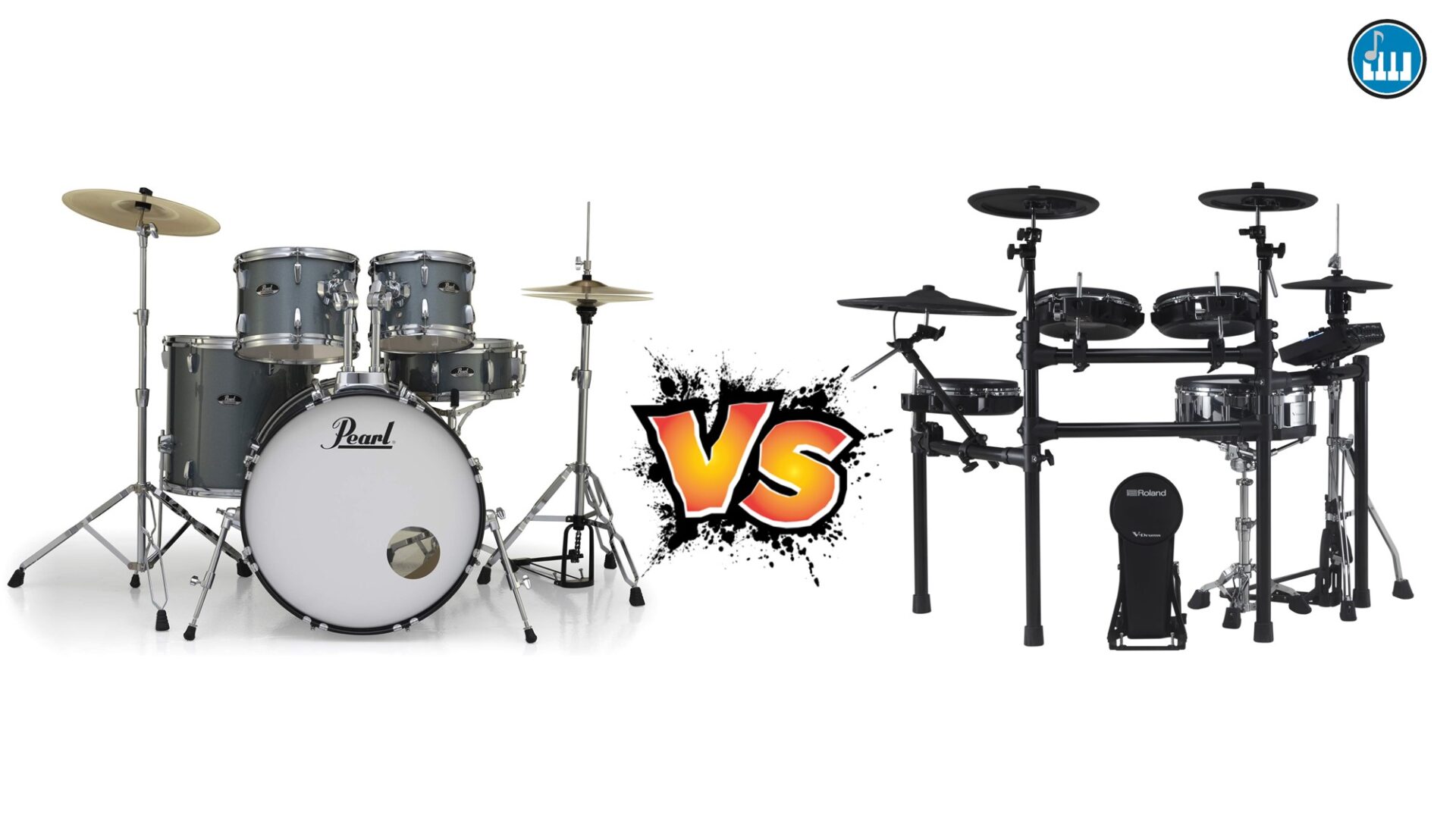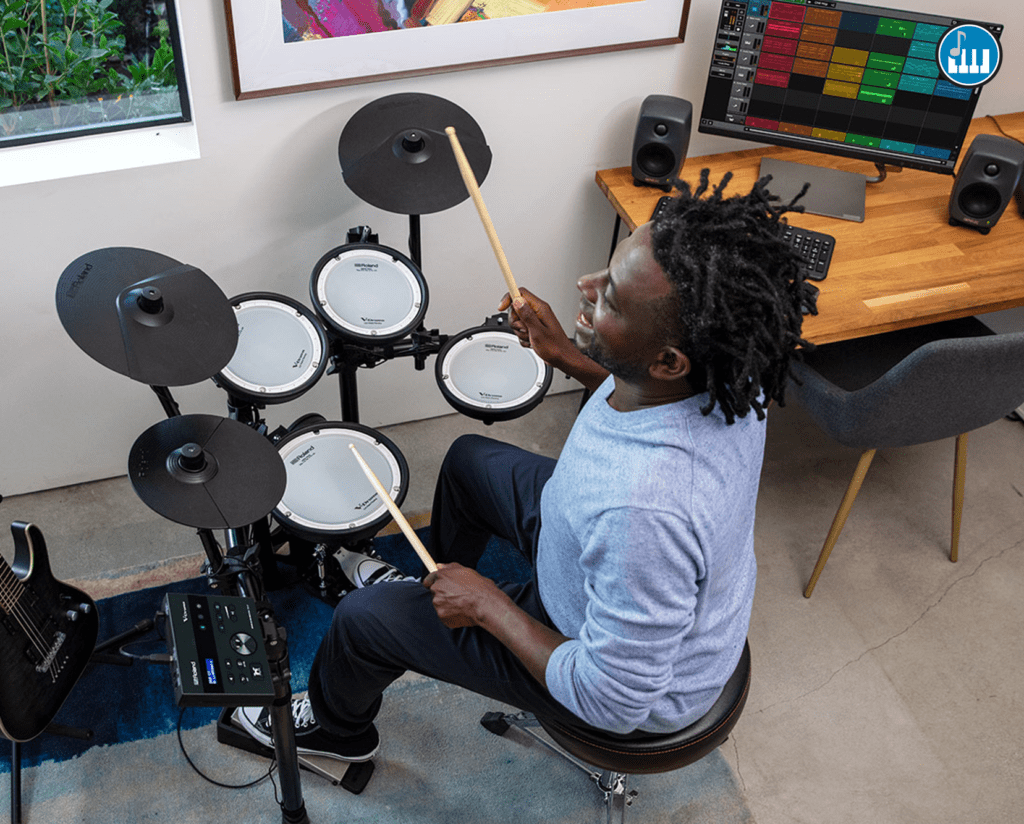Acoustic vs Electronic Drums: Which is Better for You?

Acoustic vs electronic drums, characteristics, advantages and disadvantages of each, and all the information so you know which one is best for you.
Table of Contents
Analysis of acoustic and electronic drums
Choosing a drum kit is a crucial decision for beginner and experienced drummers. Do you gravitate towards the rich resonance and authenticity of an acoustic drum kit or are you seduced by the versatility and practicality of an electronic drum kit? In this post we will analyze the characteristics, differences, advantages and disadvantages of acoustic drums and electric or electronic drums. At the end of this tour, you will be prepared with all the information necessary to make an informed decision and know which is the best choice for your style, preferences, and musical needs. Join us in this exciting analysis that will help you find the perfect rhythm for you!
You may also be interested in our tutorial on the different types of drums.
Dimensions of the analysis of acoustic and electronic drums
To address this comparison between acoustic and electronic drums, we will dive into several crucial dimensions. We will begin by examining the sound quality and expressiveness that each type offers, delving into the essence of their dynamics. Next, we’ll delve into the feel of playing, considering how the material and response of drums and cymbals influence the drummer’s experience.
The issue of noise, a determining factor for those who share their space with other people, will also be under the microscope. Additionally, we will explore aesthetics, analyzing the visual appearance of both drums and how they can fit into different musical settings. Practicality, a dimension that can be decisive in the choice, will be broken down to evaluate the ease of adjustment, transport and configuration.
Finally, we will not leave aside an element as fundamental as the durability of both types of drums, acoustic and electric. We will also consider drumsticks, discussing how each type of drums affects the wear and tear of this essential component for the drummer. Each dimension will provide us with additional nuance in the comparison between these two percussive worlds, helping us reach an informed conclusion.
In summary, the dimensions used for the analysis of these two fabulous instruments are:
- Sound quality
- Sensation
- Noise/volume
- Versatility
- Transportability
- Durability
- Appearance
- Drumsticks
Get ready for a journey in which you will discover the rhythm that best suits your style!

Additionally, you might be interested in our list of the best cheap acoustic drum sets for beginners.
Sound quality in acoustic and electronic drums
The truth is that the two drums sound incredible, but there is one thing that differs a lot: the acoustic drums of the electronic drums, and the word is dynamic. Yes, here we love dynamics and the truth is that the electric drums have very good dynamics, the sensors are very good but they do not match what acoustics are. I mean, putting together Ghost Notes takes on an acoustic is a real delight and doesn’t compare to doing them on electronic drums.
Thus, the range of notes that an acoustic has is infinite and beautiful, low, medium, high, which is not there in electric drums because in the end we depend on sensor technology. So sometimes it doesn’t do exactly what we want. For example, playing the cymbal with something soft and it sounds very loud is not respecting these dynamics.
Maybe, if you are a beginner, you won’t feel the difference as much. But as you progress with your studies, you will develop dynamics more and that is where you will find the limitations of electronic drums.
So, round number one clearly goes to the acoustic drums.
Acoustic vs electronic drum feel
The difference in the sensation when playing both drums is noticeable. The materials of both drums are completely different. For example, the snare of the acoustic is very tense and hard, while in the electric, despite being tied, you do not have that same tension. The bounces are not similar, so the feeling is very different.
The biggest difference is in the cymbals, since the electric ones are made of plastic and do not have the same natural movement as the acoustic cymbals. With electronic drums, the impact goes directly to your wrists because they are made of plastic. Therefore, this round goes to the acoustic drums again.

We also recommend that you visit our selection of the best cheap electronic drums for beginners.
Noise/volume of acoustic and electronic drums
Let’s talk about noise. An acoustic drum set is noisy, your neighbors – and also whoever you live with – must hate you if you have an acoustic one. On the other hand, an electric drum set is much quieter, making it ideal for practicing at home without disturbing the neighbors. Although, when you hit the pads of the electronic drums you make noise, it is nothing compared to that of an acoustic one. Thus, by getting yourself in a room, with good headphones, you can play practically all the time whatever you want. Therefore, round number three goes to the electric drums.
Versatility of acoustic drums and electronics
Acoustic drums are not versatile when it comes to changing sounds. You should tune each drum one by one if you want different sounds, and replace the cymbals entirely if you want changes in that regard. Also, there are things that you won’t be able to change without changing the drum set itself when it comes to an acoustic. On the other hand, electric drums offer great practicality, since you can easily change sounds through the module without needing to tune. This makes it highly practical and versatile.
Thus, you can have a drum set to play Heavy-Metal music, with a configuration change in seconds you can have one for Hard-Rock, Jazz, Reggae, electronic or whatever you want. So this round goes to the electric drums.

Acoustic vs Electronic Drum Transportability
You don’t need to have had an acoustic drum set to know or imagine how complicated it is to transport a drum kit. Also, how long it takes to put it back together and take it apart. We drummers always have more time to prepare and close the shows.
On the other hand, the electric or electronic drums are much easier to transport due to the smaller size of its parts. Thus, this round goes to the electronic drums.
Durability of acoustic and electronic drums
Acoustic drums, if you take care of them and do not expose them to aggressive environments – extreme heat or cold, water or humidity, etc. – last a long time, and the only maintenance required is changing the drum heads. In addition, although the cymbals of acoustic drums suffer wear and tear and can crack if you do not treat them correctly. However, they last for years with proper care.
On the electronic drum set side, it has electronic components that, although they can last for years, are also susceptible to damage, burns or breakage. In this sense, we can say that electric drums are a little more fragile and delicate. Without going into the aspect of obsolescence, as happens with any electronic and / or technological device. Thus, this round is won by the acoustic drums.
Appearance of acoustic vs electronic drums
Appearance is one aspect where acoustic drums excel. The combination of colors with the cymbals, the drums themselves, the snare and the cowbell make it look spectacular. On the other hand, electric drums, although also attractive, do not look as sensual as acoustic ones. In addition, the presence of cables in the electrical system can be a negative point in terms of appearance. Thus, the fifth round goes to the acoustic drums.
In this sense, acoustic drums have an advantage in this round.
Wear of drumsticks in acoustic vs electronic drums
Drumsticks are an important element to consider. With an acoustic drum set, you need a lot of drumsticks as they tend to wear out quickly due to the force required. On the other hand, with an electric drum set, the drumsticks tend to last much longer, since wear is minimal due to the material of the pads. Therefore, in this round, the electric drum set takes the victory.
You may be interested in knowing which are the best brands of drum sticks.
Conclusion on acoustic vs electronic drums
After eight rounds, the result is for the acoustic drums in terms of audio quality and playing sensation, while the electronic drums win in terms of practicality and versatility. When we started this review we thought that the acoustic drums were going to win easily, but in reality, it was a very even competition. This is because both drums are amazing, but they are ideal for different situations.
Choosing between an acoustic drum set and an electric drum set will depend on your individual needs and preferences. Both are wonderful in their own context, and it is important to recognize when it is more appropriate to use one or the other.
| Dimension | Acoustic Drums | Electronic Drums |
|---|---|---|
| Sound quality | x | |
| Sensation | x | |
| Noise/volume | x | |
| Versatility | x | |
| Transportability | x | |
| Durability | x | |
| Appearance | x | |
| Drumsticks -wear- | x |
We hope this detailed look at the differences between acoustic and electronic drums has helped you better understand which might be the right choice for you in different situations. Both have their own advantages and charm, so the final choice will depend on your personal needs and preferences.
Let us know if there are any other dimensions that you think we should have considered for this comparison between acoustic drums vs. electric drums.
Thank you for reading our article and we hope you found it useful!
Maybe you want to delve deeper into the topic, for this we recommend the following guide on all types of drums, from acoustic to electronic.



